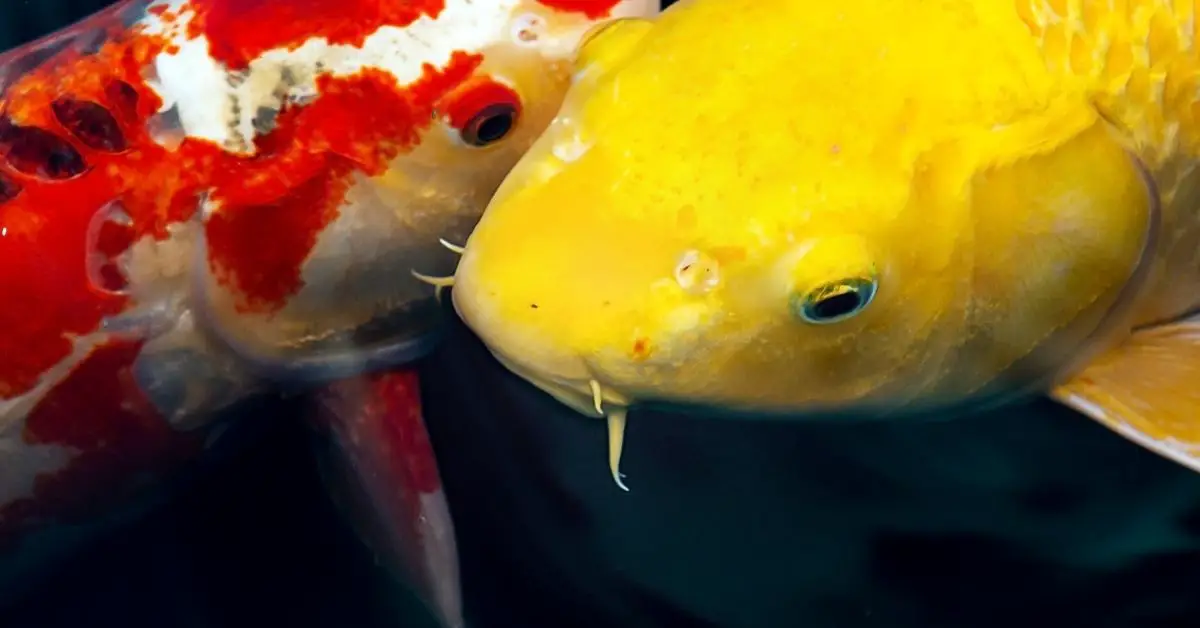There are many different types of KOI fish, but all have one thing in common – barbels. These whisker-like appendages come from the mouth and hang down like a mustache or beard on the lower lip. There are two sets of these barbels, a set on top of each side of the mouth. They serve as sensory organs to help them feed by sensing food particles in the water.
KOI fish also use their barbels for other purposes such as communicating with other KOI fish or finding a mate during the breeding season. Males will flare their barbel out when they want to court female KOI fish, females will flare theirs when they’re ready to spawn eggs, and both sexes will flare their barbs when defending territory.
It is thought that the barbels help them “taste” food by sensing its chemical composition in the water. There are also reports from South Africa stating that captive-bred carp (koi’s wild cousin) will flare their barbels when they sense another water creature, such as a catfish.
When do KOI get their barbels?
KOI are born without any barbels. When they are a few weeks old, the first set of barbels appear. These barbels are only temporary and will fall off in a matter of months. The next set of barbels will take anywhere from one to two years to grow in on the bottom lip but don’t worry, the first set of barbels will grow back.
In order for the second pair to grow in, they must be fed food that contains protein. Think about how you feel when you haven’t eaten for a few hours, it’s hard to think straight and your stomach starts growling like crazy. A barbel needs protein in order for it to grow to its full potential.
Cutter Backyard Bug Control Spray Concentrate (2 Pack), Kills Mosquitoes, Fleas & Listed Ants, 32 fl Ounce
26% OffEAST OAK Outdoor Storage Box, 31 Gallon Deck Box Indoor and Outdoor Use, Waterproof Resin Storage Bin for Package Delivery, Patio Cushions, Gardening Tools, Outdoor Toys, Lockable, UV Resistant, Grey
13% Offaddlon 100FT(50FT*2) LED Outdoor String Lights Waterproof Patio Lights with 32 Shatterproof ST38 Replaceable Bulbs(2 Spare), Dimmable Outside Hanging Lights Connectable for Porch, Backyard, 2200K
22% OffThe third and final set of barbels will appear between 3 and 4 years old, with the same stipulations as before (protein).
KOI fish do not get their barbels until they are one to two inches long.
What does it mean when my KOI has no barbels?
There are three different scenarios when your Koi does not have obvious barbels:
- It is a young fish, under the size of one inch.
- The fish has had its barbels removed or broken off through improper netting while it was being transferred to another pond or tank.
- The “Koi” is a goldfish or a carp, which are both members of the minnow family. Goldfish and carp do not grow barbels.
Although it’s hard to believe that young fish have any barbels at all, they really do. When you look closely enough into their mouths (perhaps with a magnifying glass), you’ll see a tiny little non-functional barbel. Again, this is a temporary barbel and will fall off in a few months.
The second scenario is more common than you think. Why let an injured barb grow back when it’s just going to get hurt again? Fish store owners will often cut off broken and damaged barbels during the netting process so that the fish doesn’t have to be stressed out by an injury.
If you’re debating if a fish really is a KOI, the place on its cheek where the barbels grow from is about as unique and characteristic as they come. If you see two black dots on either side of the mouth that are positioned vertically instead of horizontally, then chances are it’s a KOI.
Do baby KOI have barbels?
Baby KOI have barbels but at a very tiny size. They are only present for a few weeks to maybe months and will fall off in a year or two. How quickly these barbels fall off depends on how fast the fish grows and since the speed of growth is relative to food quality, it’s important to provide proper nutrition during the growing phase.
What do barbels look like?
The first set of barbels are less developed than the second and third sets and appear as little stubby things that poke out from just under the lower lip. They are clear and almost look like little growths instead of barbels.
The second set of barbels will start to grow on the bottom lips and are clearly visible. The first set of barbels stay temporarily for a few months while they regrow, then fall off again.
The third pair of barbels are usually much larger than the first two sets and can be anywhere from one to three inches long. These barbels may droop down a bit and some fish have trouble swimming with them.
Barbels can be white, brown, or black. Some people even dye their Koi’s barbel to match the color of their scales, but please don’t do this. Dyeing these barbels can kill your fish by clogging its gills, so don’t do it.
In Conclusion
The first set of barbels are less developed than the second and third sets and appear as little stubby things that poke out from just under the lower lip. They are clear and almost look like little growths instead of barbels.
The second set of barbels will start to grow on the bottom lips and are clearly visible. The first set of barbels stay temporarily for a few months while they regrow, then fall off again.
The third pair of barbels are usually much larger than the first two sets and can be anywhere from one to three inches long. These barbels may droop down a bit and some fish have trouble swimming with them.





















